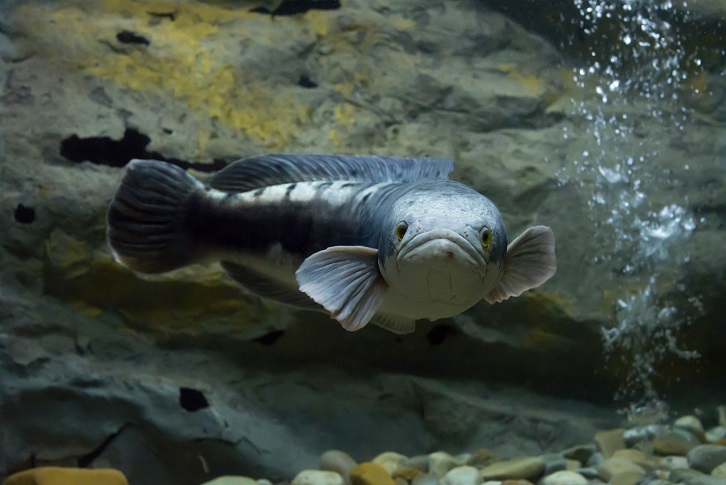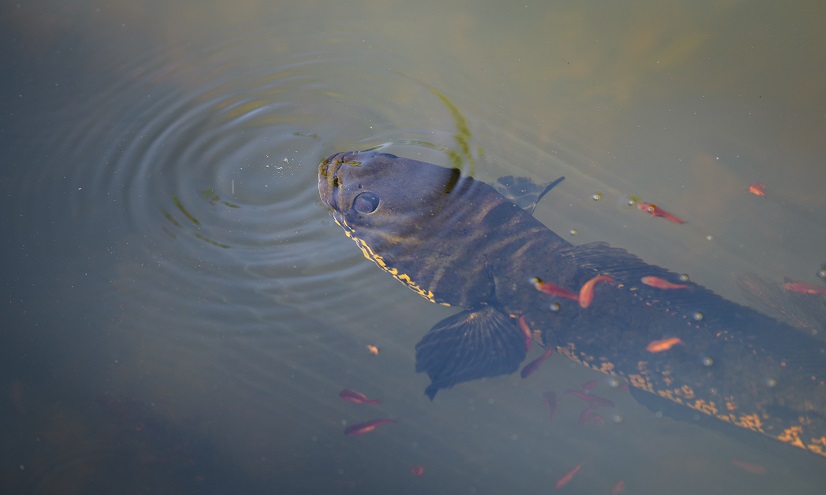June 05, 2024
At Restorasi Ekosistem Riau (RER) the key to conservation is developing an in-depth understanding of species and the ways they interact with their environment. This in turn allows us to develop effective preservation strategies, in response to the unique challenges each animal or habit is facing.
In this article, we will study the differences between the two snakehead fish species commonly found in RER. Both play a critical ecosystem role, while also providing nutrition and a source of livelihood to local people. But they also have some unique characteristics that set them apart. Let’s take a closer look.
1. Their taxonomy
Found all over Asia, snakeheads are a diverse group of freshwater predatory fish. In terms of their taxonomy, they belong to the Channidae family and the genus Channa, which includes about 50 different species.
Two of the most common are the striped snakehead (Channa striata) and the giant snakehead (Channa micropeltes). While both species share certain similarities in their appearance and behaviour, there are some unique differences in terms of how they look, where they live, and the ecological roles they play.
2. How they look
Let’s begin with their appearance. As the name suggests, giant snakeheads tend to be much larger than their striped cousins. Known as ‘toman’ or sometimes ‘toman harimau’ in the local language (a title which compares them to tigers), giant snakeheads really live up to their name. Adults can grow up to 1.5 metres (4.9 ft) in length and weigh up to 20 kg (44 lbs).
Conversely, striped snakeheads, popularly known as ‘gabus’, generally grow to around half the size of their giant relatives, although some have been found that measure around a metre in length. Something else that sets them apart is their comparatively elongated body shape.

You can also spot a giant snakehead by the distinctive bump on the head, which is not present in the more streamlined striped species. Both species come in a range of colours, but giant snakeheads tend to be patterned with dark spots and stripes. Meanwhile, somewhat counterintuitively, striped snakeheads are duller in their colouration.
Interestingly, juvenile giant snakeheads are an eye-catching crimson colour, with orange and black lateral stripes appearing after about two months. As the giant snakehead matures, this colouration starts to fade into a bluish-black on the upper body while white on underbelly.
3. Habitat and distribution
Both species live in freshwater lakes, rivers and swamps throughout Southeast Asia. However, given their larger size, giant snakeheads tend to prefer bigger bodies of water like lakes and reservoirs.
The smaller and more nimble striped snakeheads are a little more adaptable. They are suited to a diverse range of water worlds, and can even migrate from rivers and lakes into flooded fields. They return to permanent water bodies in the dry season, where they survive by burrowing into the mud. Sometimes young fish can be found in rice fields, leading to their Malay name ‘toman padi’, with padi meaning rice.
4. Unique characteristics and behavioural traits
Snakeheads breathe air directly from the water surface. Their gills are rudimentary, and they rely on a primitive lung that’s located just behind the gills for gas exchanges. If they unable to reach the surface, entangled in nets for example, they will die of suffocation. This unique adaptation enables them to survive even in still or stagnant water that is low in oxygen. In RER, you can sometimes see them hauling their bodies overland between rivers, gulping air as they go.
Striped snakeheads also exhibit some interesting behaviour, especially during the breeding season. During this time, males and females pair up and work together to build a nest out of water vegetation, and then take turns to guard the eggs from predation.

After these eggs hatch, the fry are reddish orange in colour. The parents will continue to watch over them and keep them safe until they grow big enough to fend for themselves (5–6 cm) and turn a greenish-brown colour. Whether as devoted parents or air-breathing landlubbers, both species are full of surprises.
5. Ecosystem roles
Giant snakeheads tend to be the apex predators in their ecosystems, and this means they are responsible for regulating all kinds of prey species. In addition to fish, these voracious hunters also feast on crustaceans, insects and amphibians. In contrast, the smaller and more adaptable striped variety play a more generalised role in their ecosystems.
Both species are aggressive hunters, who lurk in ambush for unsuspecting prey. But there are also some notable differences in their behaviour: Giant snakeheads are known to be territorial, defending their feeding grounds from intruders; whereas striped snakeheads are more opportunistic, roaming around in search of an easy meal and generally avoiding conflict with their competitors.
When cultivated effectively in sustainable fisheries, populations of giant snakeheads can be an effective tool in controlling the overpopulation of tilapia. You can find out more about these species, and their role in the RER ecosystem, by reading this article.
Snakeheads in RER
Channa micropeltes and Channa striata are just two of the 89 fish species that have been recorded so far in RER.
These two fish play an especially important role in RER, because they provide a reliable source of income for local fishermen. Their ability to breath directly from the air and their durability enable the fishermen to transport them alive to the market. Focusing on the four rivers that crisscross RER (the Kutup, Sangar, Serkap and Turip) RER is working together with these communities to ensure fishing practices remain sustainable, with minimal impacts on the forest and the wildlife it supports.
Together with local fishermen and international scientists, researchers at RER continue studying snakeheads to develop a more in-depth understanding of these animals and the complex roles they play in their environment. As with all the many species living in the RER landscape, knowledge is the key to understanding, and understanding can open the door to a more sustainable future.